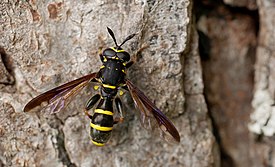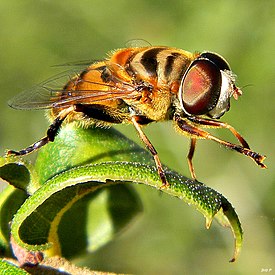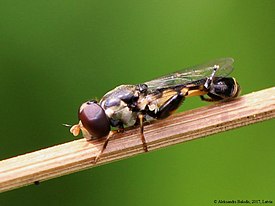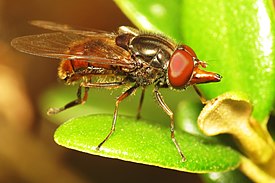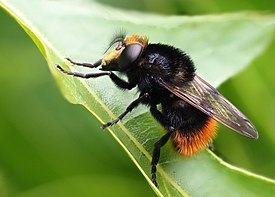Eristalinae
| Eristalinae | |
|---|---|

| |
| Volucella zonaria ♀ specimen, dorsal perspective | |
| Scientific classification | |
| Domain: | Eukaryota |
| Kingdom: | Animalia |
| Phylum: | Arthropoda |
| Class: | Insecta |
| Order: | Diptera |
| Family: | Syrphidae |
| Subfamily: | Eristalinae |
| Tribes | |
|
See text | |
| Synonyms | |
| |
Eristalinae (or Milesiinae) are one of the four subfamilies of the fly family Syrphidae, or hoverflies. A well-known species included in this subfamily is the dronefly, Eristalis tenax.[1][2][3]
Species in this subfamily are often misclassified as bees instead of flies due to their exceptional Mimicry, especially to resemble Honeybees (family Apidae). The best strategy for proper identification is to look at their eyes and wings and compare with fly morphology, to determine membership of family Syrphidae and/or of order Hymenoptera.
Taxonomy
This subfamily consists of the following tribes:
gallery
-
Sphiximorpha subsessilis
-
Palpada sp.
-
Sericomyia chalcopyga
-
Volucelle bourdon actual size 11–17 mm (3⁄8–5⁄8 in)
Ecology
This subfamily has the widest range of larvae habitat of any in Syrphidae. Larvae live in sap trails, under bark, in rot-holes in trees, in decaying organic material such as dung and compost, and in shallow aquatic environments. Most larvae feed on decaying organic debris. They are filter feeders in many kinds of aquatic media. They purify water by filtering microorganisms and other products. Some feed on bulbs and are considered garden pests.[4]
Certain species in Eristalinae live as scavengers and take shelter in the remains of other insects, while others, like Volucella,[5] are Parasitoids and live in wasp or bee nests. Some other species are found to be leaf miners and tunnel inside the stems and roots of plants. Additionally, males of this subfamily typically employ dual mate-seeking strategies to find females, most commonly patrolling blossoms and waiting near potential sites where females could lay eggs.[5]
References
- ^ Bartsch, Hans (2009). Tvåvingar: Blomflugor Diptera: Syrphidae: Eristalinae & Microdontinae [Flies: hoverfly Diptera: Syrphidae: Eristalinae & Microdontinae] (hardback). Nationalnyckeln/en/ (in Swedish). Vol. 2. The Swedish Taxonomy Initiative. pp. 1–478. ISBN 9789188506702.
- ^ Stubbs, Alan E.; Falk, Steven J. (2002). British Hoverflies: An Illustrated Identification Guide (2nd of Revised ed.). British Entomological and Natural History Society. p. 469. ISBN 978-1899935055.
- ^ Skevington, Jeffrey H (2019). Field Guide to the Flower Flies of Northeastern North America. ISBN 9780691189406.
- ^ Rotheray, G.E. (1993). "Colour Guide to Hoverfly Larvae (Diptera, Syrphidae) in Britain and Europe" (PDF). Diperists Digest. 9: 155.
- ^ a b Heiss, Elizabeth Madeleine (1938). "A classification of the larvae and puparia of the Syrphidae of Illinois exclusive of aquatic forms". Series: Illinois Biological Monographs. 16: 1–142.
3. [1] Bugguide.net
4. [2] Maier, C.T. (1982). Larval habitats and mate-seeking sites of flower flies (Diptera: Syrphidae, Eristalinae). Proceedings of the Entomological Society of Washington, 84, 603–609.
5. Maier, C.T. (1979). Dual Mate-Seeking Strategies in Male Syrphid Flies. Annals of the Entomological Society of America, Volume 72, Issue 1, Pages 54–61.
External links
 Media related to Eristalinae at Wikimedia Commons
Media related to Eristalinae at Wikimedia Commons Data related to Eristalinae at Wikispecies
Data related to Eristalinae at Wikispecies


